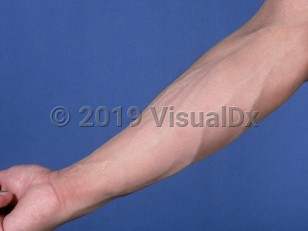Drug-induced lipodystrophy
Alerts and Notices
Important News & Links
Synopsis

The clinical manifestations include fat loss (lipoatrophy - on the face, extremities, and buttocks); fat gain (abdominal, dorsocervical, and breast lipohypertrophy); and mixed presentations (gain and loss).
The most commonly implicated ART drugs are nucleoside reverse transcriptase inhibitors, but protease inhibitors and, to a lesser extent, non-nucleoside reverse transcriptase inhibitors may less frequently be responsible.
Drug-induced lipodystrophy in patients with HIV on ART is associated with metabolic complications, an increased risk of cardiovascular disease, and pancreatitis.
Lipodystrophy can develop within months to 2 years after the initiation of ART, with changes in limb and waist circumference apparent in up to 35% of patients after 2 years of initiation of ART.
Oral corticosteroid therapy may also cause fat redistribution (both a cushingoid appearance and true, iatrogenic Cushing syndrome are possible). Lipohypertrophy or lipoatrophy can occur at insulin injection sites, and lipohypertrophy at pegvisomant injection sites has been reported.
Codes
E88.1 – Lipodystrophy, not elsewhere classified
SNOMEDCT:
713693008 – Lipodystrophy caused by antiretroviral drug
Look For
Subscription Required
Diagnostic Pearls
Subscription Required
Differential Diagnosis & Pitfalls

Subscription Required
Best Tests
Subscription Required
Management Pearls
Subscription Required
Therapy
Subscription Required
Drug Reaction Data
Subscription Required
References
Subscription Required
Last Updated:12/03/2018

